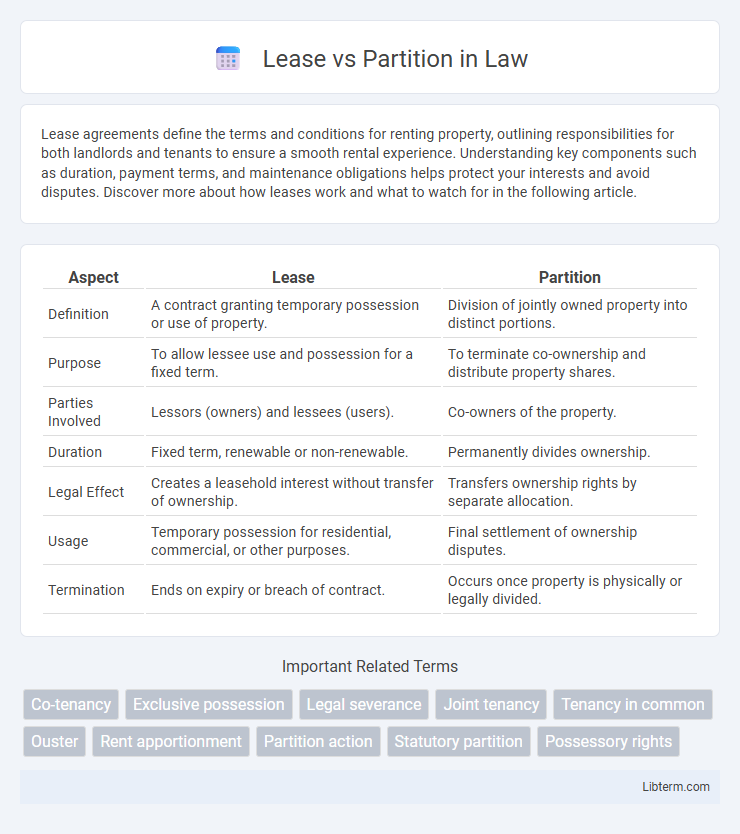Lease agreements define the terms and conditions for renting property, outlining responsibilities for both landlords and tenants to ensure a smooth rental experience. Understanding key components such as duration, payment terms, and maintenance obligations helps protect your interests and avoid disputes. Discover more about how leases work and what to watch for in the following article.
Table of Comparison
| Aspect | Lease | Partition |
|---|---|---|
| Definition | A contract granting temporary possession or use of property. | Division of jointly owned property into distinct portions. |
| Purpose | To allow lessee use and possession for a fixed term. | To terminate co-ownership and distribute property shares. |
| Parties Involved | Lessors (owners) and lessees (users). | Co-owners of the property. |
| Duration | Fixed term, renewable or non-renewable. | Permanently divides ownership. |
| Legal Effect | Creates a leasehold interest without transfer of ownership. | Transfers ownership rights by separate allocation. |
| Usage | Temporary possession for residential, commercial, or other purposes. | Final settlement of ownership disputes. |
| Termination | Ends on expiry or breach of contract. | Occurs once property is physically or legally divided. |
Introduction to Lease vs Partition
A lease grants a tenant temporary possession and use of property under a contract, typically outlining duration, rent, and tenant-landlord responsibilities. Partition involves dividing jointly owned property among co-owners to sever ownership interests, often resulting in physically separate portions or a sale followed by distribution of proceeds. Understanding the legal distinctions and practical implications of lease versus partition is crucial for property owners and tenants managing rights and obligations.
Defining Lease and Partition in Real Estate
A lease in real estate is a contractual agreement where the property owner grants the tenant the right to use and occupy the property for a specified period in exchange for rent. Partition refers to the legal division of jointly owned real property into separate portions, allowing co-owners to hold individual, distinct titles to their shares. While a lease establishes temporary possession rights, partition results in the permanent distribution of ownership interests.
Key Differences Between Lease and Partition
Lease grants temporary possession and use rights of property to a lessee, while partition involves legally dividing ownership among co-owners. Lease does not alter ownership title but establishes a contractual relationship for a fixed term, whereas partition legally separates shared property into distinct portions. Key differences include duration, legal effect on ownership, and the primary purpose of use versus ownership division.
Legal Implications of Leasing vs Partitioning
Leasing a property grants tenants temporary rights and obligates landlords to comply with contract and landlord-tenant laws, including maintenance and eviction standards. Partitioning involves legally dividing ownership interests, often requiring court authorization to dissolve co-ownership and allocate title, potentially altering property rights permanently. Lease agreements limit tenant control, while partition actions can lead to forced sales or reallocation of property shares, affecting long-term ownership structures.
Pros and Cons of Leasing Property
Leasing property offers predictable income streams and reduced management responsibilities, making it ideal for investors seeking steady cash flow without the complexities of property maintenance. However, leasing can limit long-term control over the asset and may expose owners to risks such as tenant turnover, property damage, and fluctuating rental markets. While leases provide legal frameworks to protect both parties, they may also restrict the owner's ability to repurpose or sell the property quickly compared to ownership division through partition.
Pros and Cons of Property Partition
Property partition allows co-owners to divide real estate into distinct portions, providing clear individual ownership and simplifying management. However, partition can be costly due to legal fees, may reduce the property's overall value, and cause conflicts among owners if the division is unequal or impractical. The process may also lead to forced sale under partition action, which can result in lower returns compared to cooperative leasing arrangements.
Financial Considerations in Lease vs Partition
Lease agreements typically involve predictable, recurring rental income and limited upfront costs, making them financially less complex and providing steady cash flow to property owners. Partition actions can lead to significant legal fees, court costs, and potential forced sale of property, posing higher financial risks and uncertainties for co-owners. Understanding the financial implications of lease versus partition is crucial for property stakeholders when deciding on asset management or dispute resolution strategies.
Common Scenarios: When to Lease or Partition
Leasing is ideal for exclusive, long-term access to property or equipment without ownership transfer, commonly used in real estate rentals or vehicle rentals. Partition becomes relevant in co-ownership situations where joint owners seek to divide or sell the shared property, such as in inheritance disputes or jointly purchased real estate. Choosing between lease and partition depends on whether the goal is temporary usage or permanent division of ownership rights.
Lease vs Partition: Impact on Co-Owners
Lease agreements allow co-owners to generate income from shared property without altering ownership rights, maintaining each party's proportional stake. Partition divides the property physically or by sale, terminating joint ownership and granting each co-owner individual title, which can mitigate conflicts but may reduce overall asset value. Understanding the implications of lease versus partition is essential for co-owners to manage financial benefits and ownership control effectively.
Conclusion: Choosing Between Lease and Partition
Choosing between lease and partition depends on the goals of property co-owners: leases are ideal for generating consistent rental income while maintaining shared ownership, whereas partitions are suited for dividing property to establish individual ownership and eliminate joint interests. Legal considerations, cost implications, and the nature of the property must be evaluated, as partition often involves court proceedings and potential sale or division of the asset. Co-owners seeking flexibility and ongoing collaboration typically prefer leasing agreements, while those desiring clear ownership boundaries opt for partition actions.
Lease Infographic

 libterm.com
libterm.com